Estimation of Temperature Recovery Distance and the Influence of Heat Pump Discharge on Fluvial Ecosystems
Abstract
:1. Introduction
2. Methods
2.1. Summary of Hydrothermal Energy
2.2. Area of Study
2.3. Estimation of Water Temperature Recovery Distance
2.3.1. Heat Transfer Equation
2.3.2. The EFDC Model
2.4. Data Collection and Analysis
3. Results and Discussion
3.1. Heat Transfer Equation Method
3.2. EFDC Model
3.3. Comparison of Methods
3.4. Environmental Impact of River-Water Temperature Changes
4. Conclusions
Author Contributions
Funding
Acknowledgments
Conflicts of Interest
References
- Korea Environment Institute. Study on Water Ecosystem Impact and Proper Management Plan of River Water Discharge Water Temperature; Ministry of Environment: Sejong City, Korea, 2014.
- Lessard, J.L.; Hayes, D.B. Effects of elevated water temperature on fish and macroinvertebrate communities below small dams. River Res. Appl. 2003, 19, 721–732. [Google Scholar] [CrossRef]
- Kim, S.; Noh, H.S.; Hong, S.J.; Kwak, J.W.; Kim, H.S. Impact of climate change on habitat of the Rhynchocypris Kumgangensis in Pyungchang river. J. Wetl. Res. 2013, 15, 271–280. [Google Scholar] [CrossRef]
- Daufresne, M.; Roger, M.C.; Capra, H.; Lamouroux, N. Long-term changes within the invertebrate and fish communities of the Upper Rhône River: Effects of climatic factors. Glob. Chang. Boil. 2003, 10, 124–140. [Google Scholar] [CrossRef]
- Bowles, D.S.; Fread, D.L.; Greeney, W.J. Coupled dynamic streamflow-temperature models. J. Hydraul. Div. 1977, 103, 515–530. [Google Scholar]
- Seo, I.W.; Choi, H.J.; Song, C.G. Horizontal 2-D finite element model for analysis of mixing transport of heat pollutant. J. Korean Soc. Civ. Eng. 2011, 31, 507–514. [Google Scholar]
- Edinger, J.E.; Brady, D.K.; Geyer, J.C. Heat Exchange and Transport in the Environment; Johns Hopkins University: Baltimore, MD, USA, 1974. [Google Scholar]
- Edinger, J.E.; Duttweiler, D.W.; Geyer, J.C. The response of water temperatures to meteorological conditions. Water Resour. Res. 1968, 4, 1137–1143. [Google Scholar] [CrossRef]
- Thomann, R.V.; Mueller, J.A. Principles of Surface Water Quality Modeling and Control; Harper & Row: New York, NY, USA, 1987. [Google Scholar]
- Chapra, S.C. Surface Water-Quality Modeling; Waveland Press: Long Grove, IL, USA, 2008. [Google Scholar]
- Sinokrot, B.; Stefan, H.G. Deterministic Modeling of Stream Water Temperatures: Development and Applications to Climate Change Effects on Fish Habitat; St. Anthony Falls Hydraulic Laboratory: Minneapolis, MN, USA, 1992. [Google Scholar]
- Sinokrot, B.A.; Stefan, H.G. Stream temperature dynamics: Measurements and modeling. Water Resour. Res. 1993, 29, 2299–2312. [Google Scholar] [CrossRef]
- Prats, J.; Val, R.; Dolz, J.; Armengol, J. Water temperature modeling in the Lower Ebro River (Spain): Heat fluxes, equilibrium temperature, and magnitude of alteration caused by reservoirs and thermal effluent. Water Resour. Res. 2012, 48. [Google Scholar] [CrossRef]
- Korea Institute of Energy Research. The Optimization of a Demonstration Network Plant Using Unutilized Energy Resources; Korea Institute of Energy Research: Daejeon, Korea, 2005. [Google Scholar]
- Lee, H.; Lee, W.J.; Kim, M.K.; Hwang, H.K.; Park, J.H. A Numerical Simulation of Cool Water Discharge Dispersion in the LNG Terminal. Proceedings of Korean Society of Civil Engineering 2016 Convention conference, Seoul, Korea, 2016; pp. 271–272. [Google Scholar]
- Khangaonkar, T.; Yang, Z.; DeGasperi, C.; Marshall, K. Modeling Hydrothermal Response of a Reservoir to Modifications at a High-Head Dam. Water Int. 2005, 30, 378–388. [Google Scholar] [CrossRef]
- Park, J.-C.; Yoon, J.-H.; Jung, Y.-M.; Son, J.-Y.; Song, Y.-I. Simulation of Water Temperature in the Downstream According to Withdrawal Types of Dam using EFDC Model. J. Environ. Impact Assess. 2012, 21, 715–724. [Google Scholar]
- KICT. A Study on the Heat Pump System using Municipal Waste Water as Heat Source; Ministry of Trade, Industry and Energy: Sejong City, Korea, 1995.
- Park, J.T.; Jang, K.C. An investigation on quantity of unused energy using temperature difference energy as heat source and its availability. J. Energy Eng. 2002, 11, 106–113. [Google Scholar]
- Park, J.T. Development of Present Status and Prospect of Unutilized Energy. In Proceedings of the Society of Air-Conditioning and Refrigerating Engineers of Korea, Seoul, Korea, 2003; p. 70. [Google Scholar]
- Zhao, Z.; Zhang, Y.; Mi, H.; Zhou, Y.; Zhang, Y. Experimental research of a water-source heat pump water heater system. Energies 2018, 11, 1205. [Google Scholar] [CrossRef] [Green Version]
- Jung, J.; Nam, J.; Kim, J.; Jung, S.; Kim, H.S. Feasibility Study on the Use of River Water Hydrothermal Energy in Korea: (2) Impact Assessment of the Change in Water Temperature of Return Flow on the River Environment. KSNRE 2019, 15, 9–17. [Google Scholar] [CrossRef]
- Jung, J.W.; Nam, J.S.; Jung, S.E.; Kim, J.W.; Kim, H.S. Feasibility study on the use of river water hydrothermal energy in Korea: (1) Estimation of the permitted standard discharge and determination of the potential water intake area. New Renew. Energy 2018, 14, 27–37. [Google Scholar] [CrossRef]
- Hwang, B.G. Predicting impacts of heat sources from hot spring at Gimcheon to receiving water. J. Ind. Sci. Res. 2002, 12, 1–18. [Google Scholar]
- USEPA, Environmental Fluid Dynamics Code (EFDC). Available online: https://www.epa.gov/ceam/environmental -fluid-dynamics-code-efdc (accessed on 26 September 2019).
- Lee, H.N.; Jung, K.S.; Cheon, G.H.; Hur, Y.T. An investigation and analysis of water temperature by Juam Regulation Dam outflow in downstream and Suncheon Bay. J. Korea Water Resour. Assoc. 2015, 48, 501–509. [Google Scholar] [CrossRef]
- Ajou University. A Three Dimensional Modeling Study to Estimate the Effect of Multi-Purpose Weirs on the Thermal Dynamics in the Nakdong River, Korea; Ministry of Environment: Sejong City, Korea, 2012.
- Cole, T.M.; Wells, S.A. CE-QUAL-W2: A Two-Dimensional, Laterally Averaged, Hydrodynamic and Water Quality Model Version 4.1 User Manual; US Army Corps of Engineers: Washington, DC, USA, 2018. [Google Scholar]
- Wells, S.A. CE-QUAL-W2: A Two-Dimensional, Laterally Averaged, Hydrodynamic and Water Quality Model, Version 4.2 User Manual; Portland State University: Portland, OR, USA, 2019. [Google Scholar]
- Nam, J.S. Estimation of Available River Discharge for Hydrothermal Energy Utilization and Water Temperature Recovery Distance Using EFDC Model. Master’s Thesis, Inha University Press, Incheon, Korea, 2019. [Google Scholar]
- National Institute of Biological Resources. Red Data Book of Endangered Fishes in Korea; National Institute of Biological Resources: Incheon, Korea, 2011. [Google Scholar]
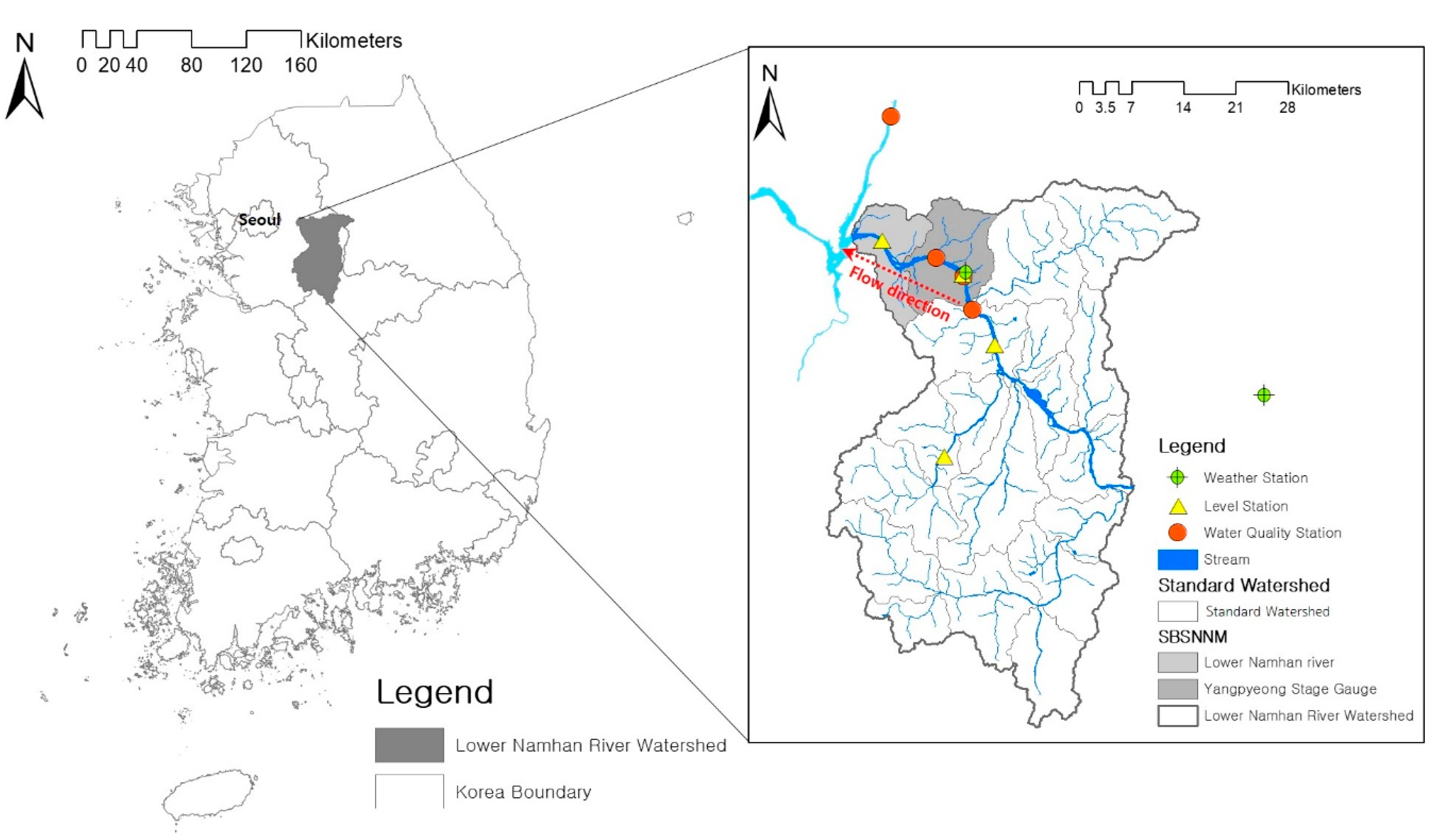
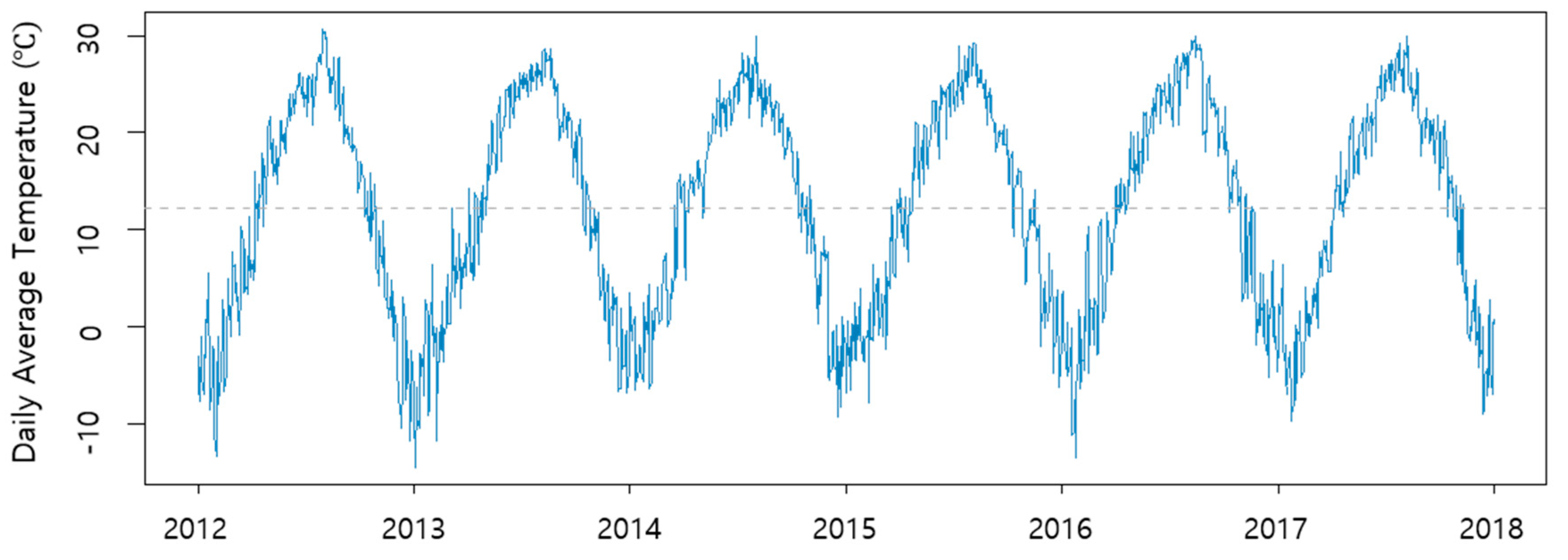

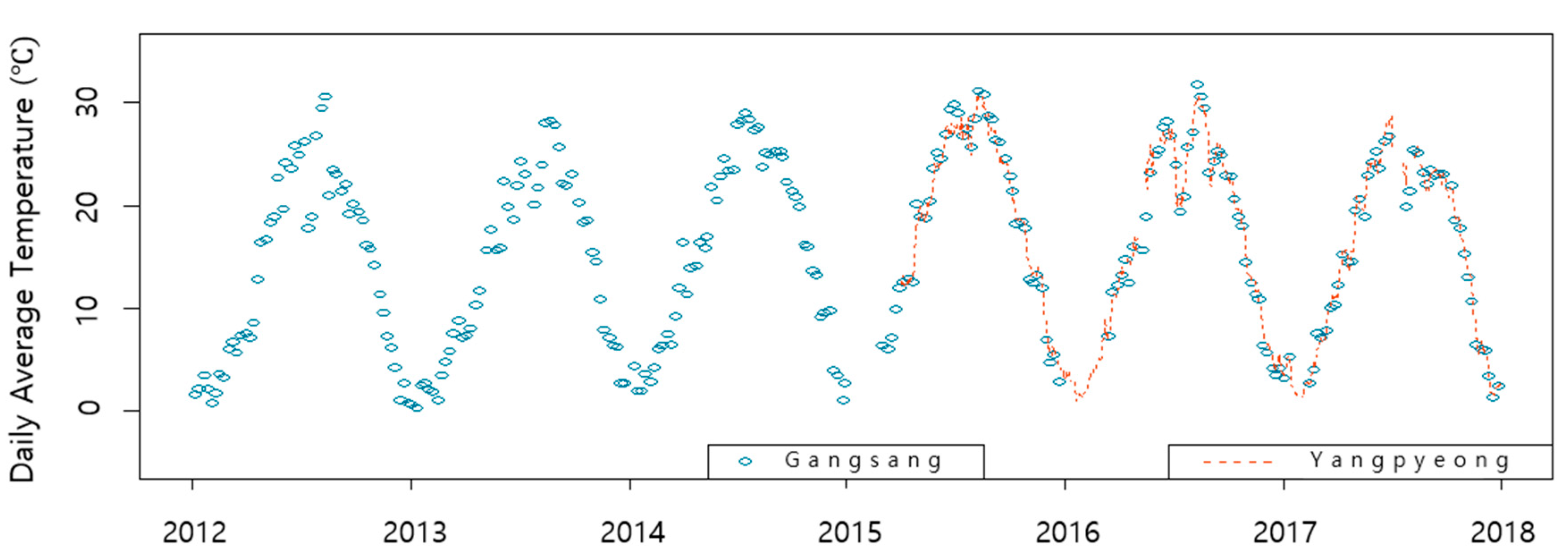
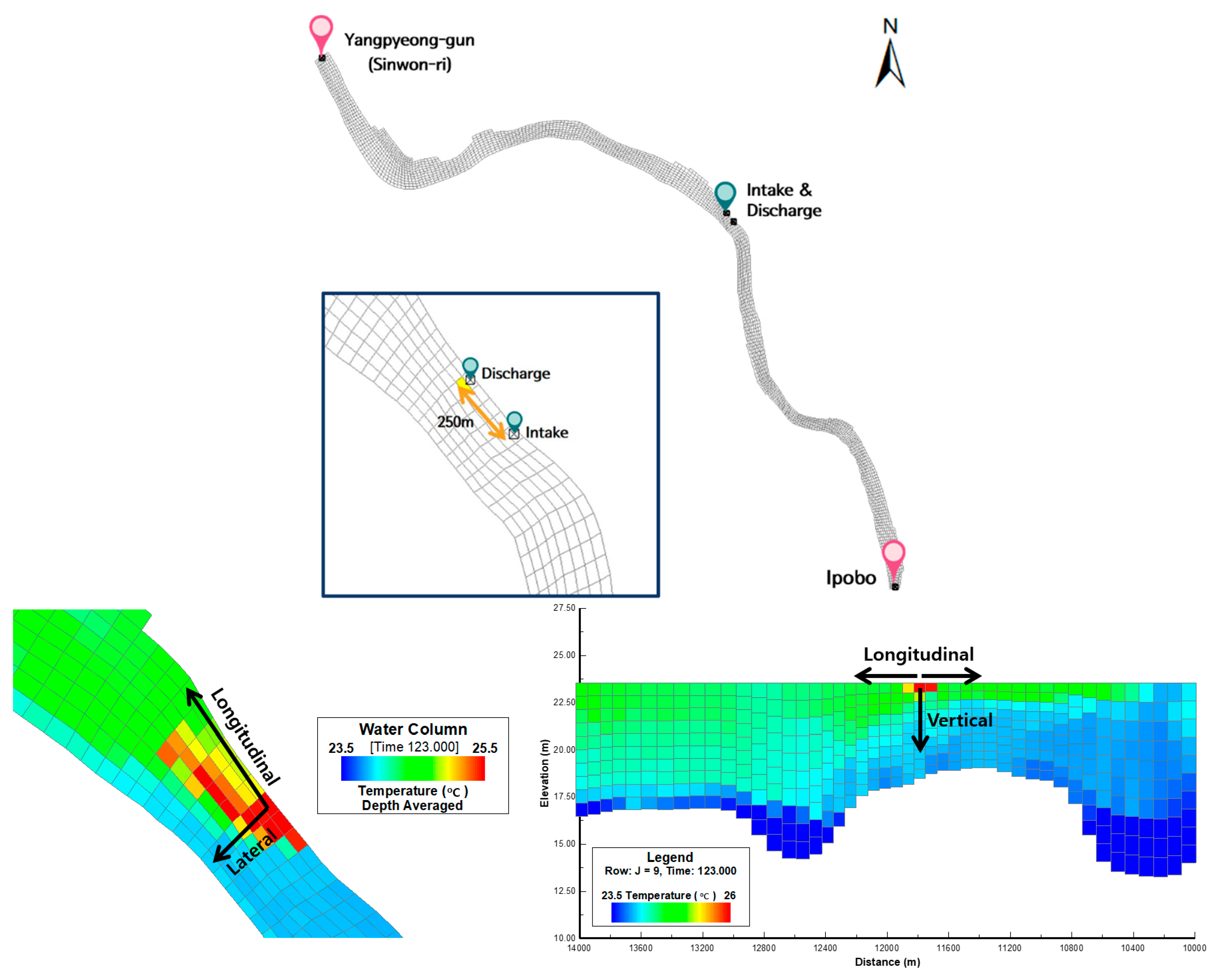
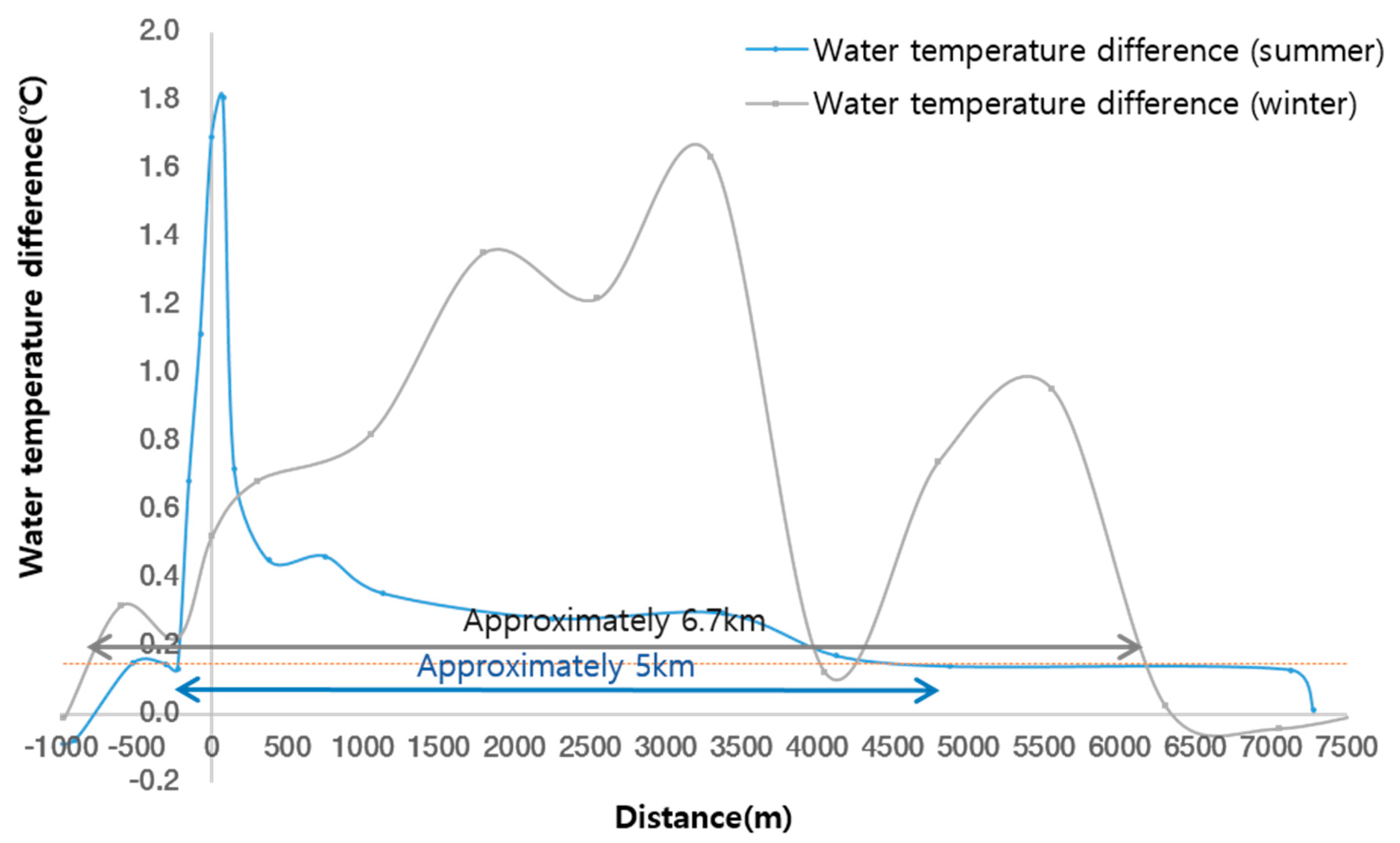
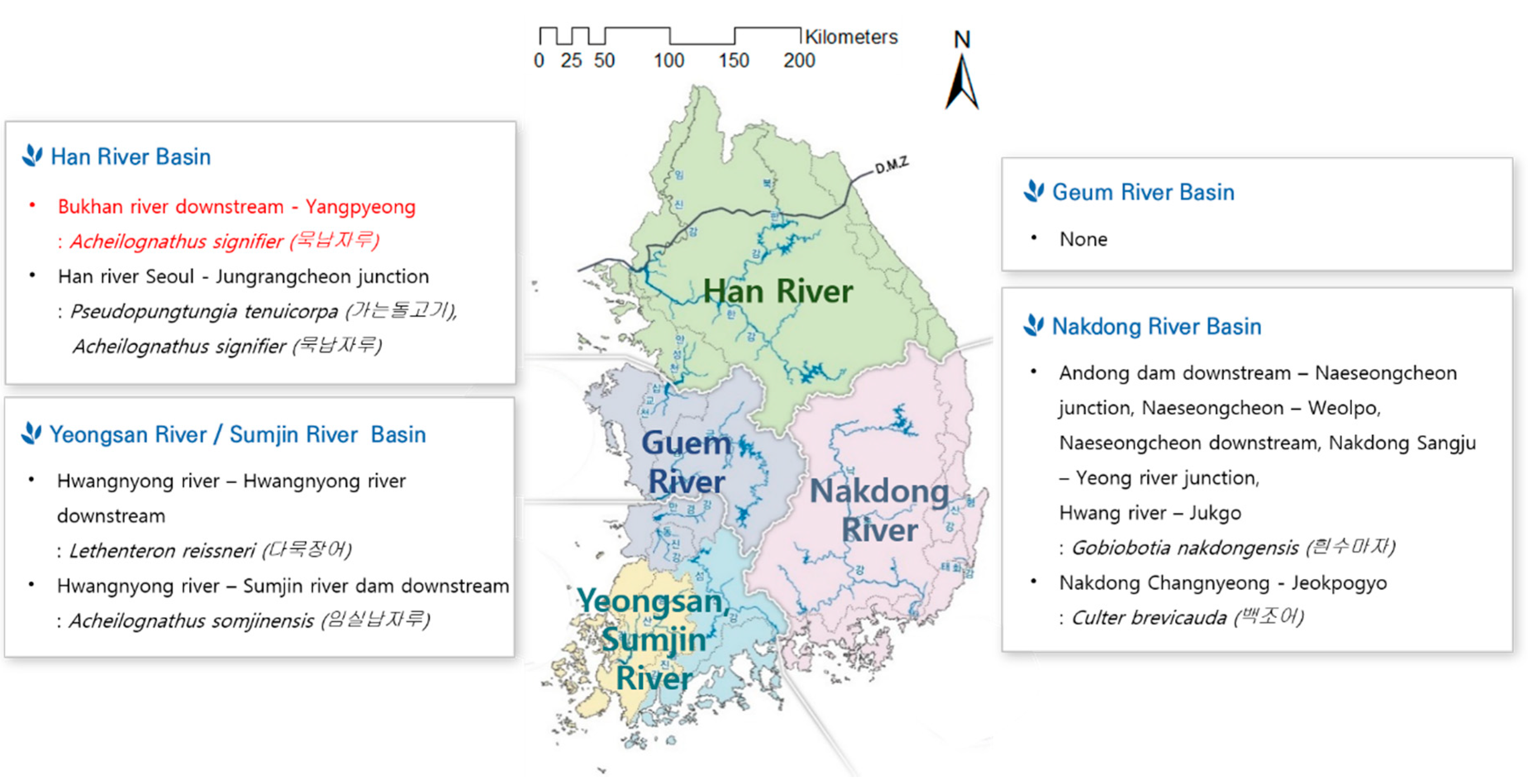
| Station Code | Station Name | Longitude (degree) | Latitude (degree) | Elevation above Sea Level (EL.m) | Observation Start (year) | Observing System |
|---|---|---|---|---|---|---|
| 114 | Wonju | 127.9 | 37.3 | 148.6 | 1971 | ASOS 1 |
| 202 | Yangpyeong | 127.5 | 37.5 | 48.0 | 1972 | ASOS |
| Station Code | Station Name | Longitude (degree) | Latitude (degree) | Zero Elevation (EL.m) | Observation Start (year) | Observing System |
|---|---|---|---|---|---|---|
| 1007697 | Yangpyeong-gun (Sinwon-ri) | 127.4 | 37.5 | 24.3 | 2016 | T/M 1 |
| 1007685 | Yangpyeong-gun (Yangpyeong Bridge) | 127.5 | 37.5 | 19. 6 | 1953 | T/M |
| 1007660 | Yeoju-si (Ipo Bridge) | 127.3 | 37.4 | 26.1 | 2001 | T/M |
| 1015645 | Gapyeong-gun (Daeseong-ri) | 127.4 | 37.7 | 22.6 | 1914 | T/M |
| Season | Temperature | Flow Rate | Depth | Velocity, () | () |
|---|---|---|---|---|---|
| Annual average | 16.3 | 203.3 | 5.7 | 0.105 | 18.0 |
| Summer average | 26.3 | 366.7 | 5.7 | 0.192 | 23.5 |
| Winter average | 3.7 | 126.9 | 5.7 | 0.006 | 13.1 |
| Summer minimum | 19.9 | 28.1 | 5.3 | 0.001 | 17.8 |
| Winter minimum | 1.0 | 16.7 | 5.2 | 0.001 | 11.8 |
| Season | River-Water Temperature, | Discharge Water Temperature | Flow Rate, Q | Mixed Water Temperature Immediately after Entry, | Wind Speed (m/s) | Change |
|---|---|---|---|---|---|---|
| Summer | 26.3 | 33.3 | 28.1 | 26.4 | 1.4 | ▲0.16 |
| Winter | 3.7 | −1.3 | 16.7 | 3.5 | 0.8 | ▼0.18 |
| Distance | 0.5 km | 5 km | 10 km | 50 km | 100 km | 300 km | Water Temperature Recovery Distance (km) |
|---|---|---|---|---|---|---|---|
| Summer () | 26.4 | 26.4 | 26.4 | 26.4 | 26.4 | 26.3 | 9.73 |
| Winter () | 3.5 | 3.6 | 3.6 | 3.6 | 3.6 | 3.7 | 4.48 |
| Season | Sea-Level Pressure | Temperature | Relative Humidity (%) | Precipitation | Solar Radiation () |
|---|---|---|---|---|---|
| Summer (6 June 2015) | 1015.0 | 19.6 | 65.5 | 0.00 | 0.85 |
| Winter (20 December 2015) | 1032.2 | −6.2 | 64.9 | 0.00 | 0.50 |
| Season | Inflow Rate | Exit Level | Influent Water Temperature (Hongcheon) | Wind Speed | |
|---|---|---|---|---|---|
| Summer | 43.3 | 25.2 | 22.6 | 1.4 | 110 |
| Winter | 16.7 | 25.3 | 2.4 | 0.8 | 200 |
| Season | Average Simulated Water Temperature | Observed Water Temperature | Median Error |
|---|---|---|---|
| Summer | 24.3 | 24.0 | 0.17 |
| winter | 1.4 | 1.5 |
| Season | Heat Transfer Equation (km) | EFDC Model (km) | ||
|---|---|---|---|---|
| Longitudinal Direction | Lateral Direction | Vertical Direction | ||
| Summer | 9.7 | 5.0 | 0.30 | 0.01 |
| Winter | 4.5 | 6.7 | 0.12 | 0.04 |
© 2020 by the authors. Licensee MDPI, Basel, Switzerland. This article is an open access article distributed under the terms and conditions of the Creative Commons Attribution (CC BY) license (http://creativecommons.org/licenses/by/4.0/).
Share and Cite
Jung, J.; Nam, J.; Kim, J.; Bae, Y.H.; Kim, H.S. Estimation of Temperature Recovery Distance and the Influence of Heat Pump Discharge on Fluvial Ecosystems. Water 2020, 12, 949. https://doi.org/10.3390/w12040949
Jung J, Nam J, Kim J, Bae YH, Kim HS. Estimation of Temperature Recovery Distance and the Influence of Heat Pump Discharge on Fluvial Ecosystems. Water. 2020; 12(4):949. https://doi.org/10.3390/w12040949
Chicago/Turabian StyleJung, Jaewon, Jisu Nam, Jungwook Kim, Young Hye Bae, and Hung Soo Kim. 2020. "Estimation of Temperature Recovery Distance and the Influence of Heat Pump Discharge on Fluvial Ecosystems" Water 12, no. 4: 949. https://doi.org/10.3390/w12040949





